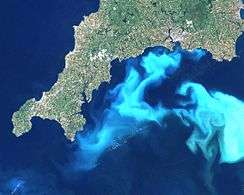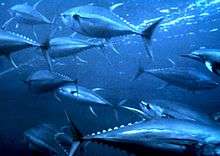Algal bloom
An algal bloom or algae bloom is a rapid increase or accumulation in the population of algae in freshwater or marine water systems, and is often recognized by the discoloration in the water from their pigments.[2] The term algae encompasses many types of aquatic photosynthetic organisms, both macroscopic, multicellular organisms like seaweed and microscopic, unicellular organisms like cyanobacteria.[3] Algal bloom commonly refers to rapid growth of microscopic, unicellular algae, not macroscopic algae. An example of a macroscopic algal bloom is a kelp forest.[3]

Algal blooms are the result of a nutrient, like nitrogen or phosphorus from fertilizer runoff, entering the aquatic system and causing excessive growth of algae. An algal bloom affects the whole ecosystem. Consequences range from the benign feeding of higher trophic levels, to more harmful effects like blocking sunlight from reaching other organisms, causing a depletion of oxygen levels in the water, and, depending on the organism, secreting toxins into the water. The process of the oversupply of nutrients leading to algae growth and oxygen depletion is called eutrophication. Blooms that can injure animals or the ecology are called "harmful algal blooms" (HAB), and can lead to fish die-offs, cities cutting off water to residents, or states having to close fisheries.
Bloom Characterization
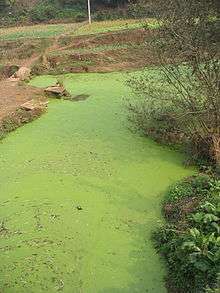
The term "algal bloom" is defined inconsistently depending on the scientific field and can range between a "minibloom" of harmless algae to a large, harmful bloom event.[4] Since 'algae' is a broad term including organisms of widely varying sizes, growth rates, and nutrient requirements, there is no officially recognized threshold level as to what is defined as a bloom. Because there is no scientific consensus, blooms can be characterized and quantified in several ways: measurements of new algal biomass, concentration of photosynthetic pigment, quantification of the bloom's negative effect, or relative concentration of the algae compared to the rest of the microbial community.[4] For example, definitions of blooms have included when the concentration of chlorophyll exceeds 100 mg/L,[5] when the concentration of chlorophyll exceeds 5 ug/L,[6] when the species considered to be blooming exceeds concentrations of 1000 cells/mL,[7] and when the algae species concentration simply deviates from its normal growth.[8][9]
Blooms are the result of a nutrient that the particular algae need being introduced to the local aquatic system. This growth-limiting nutrient is typically nitrogen or phosphorus, but can also be iron, vitamins, or amino acids.[3] There are several mechanisms for the addition of these nutrients in water. In the open ocean and along coastlines, upwelling from both winds and topographical ocean floor features can draw nutrients to the photic, or sunlit zone of the ocean.[10] Along coastal regions and in freshwater systems, agricultural, city, and sewage runoff can cause algal blooms.[11] Two examples of anthropogenic algal blooms in the United States are in Lake Erie and the Gulf of Mexico.[12]
Algal blooms, especially large algal bloom events, can reduce the transparency of the water and can discolor the water.[3] The photosynthetic pigments in the algal cells, like chlorophyll and photoprotective pigments, determine the color of the algal bloom. Depending on the organism, its pigments, and the depth in the water column, algal blooms can be green, red, brown, golden, and purple.[3] Bright green blooms in freshwater systems are frequently a result of cyanobacteria (colloquially known as "blue-green algae") such as Microcystis.[3][13] Blooms may also consist of macroalgal (non-phytoplanktonic) species. These blooms are recognizable by large blades of algae that may wash up onto the shoreline.[14]
Once the nutrient is present in the water, the algae begin to grow at a much faster rate than usual. In a minibloom, this fast growth benefits the whole ecosystem by providing food and nutrients for other organisms.[9] Of particular note are the rare harmful algal blooms (HABs), which are algal bloom events involving toxic or otherwise harmful phytoplankton. There are many species that can cause harmful algal blooms. For example, Gymnodinium nagasakiense can cause harmful red tides, dinoflagellates Gonyaulax polygramma can cause oxygen depletion and result in large fish kills, cyanobacteria Microcystis aeruginosa can make poisonous toxins, and diatom Chaetoceros convolutus can damage fish gills.[15]
Freshwater algal blooms
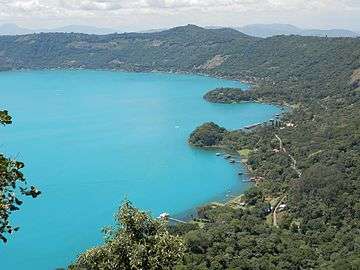
Freshwater algal blooms are the result of an excess of nutrients, particularly some phosphates.[16][17] The excess of nutrients may originate from fertilizers that are applied to land for agricultural or recreational purposes. They may also originate from household cleaning products containing phosphorus.[18] In lakes that are stratified in the summer, autumn turnover can release substantial quantities of bio-available phosphorus potentially triggering algal blooms as soon as sufficient photosynthetic light is available.[19] Excess nutrients can enter watersheds through water runoff.[20] Excess carbon and nitrogen have also been suspected as causes. Presence of residual sodium carbonate acts as catalyst for the algae to bloom by providing dissolved carbon dioxide for enhanced photosynthesis in the presence of nutrients.
When phosphates are introduced into water systems, higher concentrations cause increased growth of algae and plants. Algae tend to grow very quickly under high nutrient availability, but each alga is short-lived, and the result is a high concentration of dead organic matter which starts to decay. The decay process consumes dissolved oxygen in the water, resulting in hypoxic conditions. Without sufficient dissolved oxygen in the water, animals and plants may die off in large numbers. This may also be known as a dead zone. Use of an Olszewski tube can help combat these problems with hypolimnetic withdrawal.
Blooms may be observed in freshwater aquariums when fish are overfed and excess nutrients are not absorbed by plants. These are generally harmful for fish, and the situation can be corrected by changing the water in the tank and then reducing the amount of food given.
Harmful algal blooms
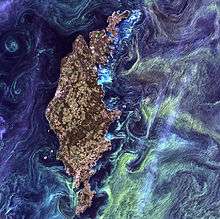
A harmful algal bloom (HAB) is an algal bloom that causes negative impacts to other organisms via production of natural toxins, mechanical damage to other organisms, or by other means. The diversity of these HABs make them even harder to manage, and present many issues, especially to threatened coastal areas. [21]HABs are often associated with large-scale marine mortality events and have been associated with various types of shellfish poisonings.[22]
In studies at the population level bloom coverage has been significantly related to the risk of non-alcoholic liver disease death.[23]
Background
In the marine environment, single-celled, microscopic, plant-like organisms naturally occur in the well-lit surface layer of any body of water. These organisms, referred to as phytoplankton or microalgae, form the base of the food web upon which nearly all other marine organisms depend. Of the 5000+ species of marine phytoplankton that exist worldwide, about 2% are known to be harmful or toxic.[24] Blooms of harmful algae can have large and varied impacts on marine ecosystems, depending on the species involved, the environment where they are found, and the mechanism by which they exert negative effects.
Harmful algal blooms have been observed to cause adverse effects to a wide variety of aquatic organisms, most notably marine mammals, sea turtles, seabirds and finfish. The impacts of HAB toxins on these groups can include harmful changes to their developmental, immunological, neurological, or reproductive capacities. The most conspicuous effects of HABs on marine wildlife are large-scale mortality events associated with toxin-producing blooms. For example, a mass mortality event of 107 bottlenose dolphins occurred along the Florida panhandle in the spring of 2004 due to ingestion of contaminated menhaden with high levels of brevetoxin.[25] Manatee mortalities have also been attributed to brevetoxin but unlike dolphins, the main toxin vector was endemic seagrass species (Thalassia testudinum) in which high concentrations of brevetoxins were detected and subsequently found as a main component of the stomach contents of manatees.[25]
Additional marine mammal species, like the highly endangered North Atlantic right whale, have been exposed to neurotoxins by preying on highly contaminated zooplankton.[26] With the summertime habitat of this species overlapping with seasonal blooms of the toxic dinoflagellate Alexandrium fundyense, and subsequent copepod grazing, foraging right whales will ingest large concentrations of these contaminated copepods. Ingestion of such contaminated prey can affect respiratory capabilities, feeding behavior, and ultimately the reproductive condition of the population.[26]
Immune system responses have been affected by brevetoxin exposure in another critically endangered species, the loggerhead sea turtle. Brevetoxin exposure, via inhalation of aerosolized toxins and ingestion of contaminated prey, can have clinical signs of increased lethargy and muscle weakness in loggerhead sea turtles causing these animals to wash ashore in a decreased metabolic state with increases of immune system responses upon blood analysis.[27] Examples of common harmful effects of HABs include:
- the production of neurotoxins which cause mass mortalities in fish, seabirds, sea turtles, and marine mammals
- human illness or death via consumption of seafood contaminated by toxic algae[28]
- mechanical damage to other organisms, such as disruption of epithelial gill tissues in fish, resulting in asphyxiation
- oxygen depletion of the water column (hypoxia or anoxia) from cellular respiration and bacterial degradation
Due to their negative economic and health impacts, HABs are often carefully monitored.[29][30]
HABs occur in many regions of the world, and in the United States are recurring phenomena in multiple geographical regions. The Gulf of Maine frequently experiences blooms of the dinoflagellate Alexandrium fundyense, an organism that produces saxitoxin, the neurotoxin responsible for paralytic shellfish poisoning. The well-known "Florida red tide" that occurs in the Gulf of Mexico is a HAB caused by Karenia brevis, another dinoflagellate which produces brevetoxin, the neurotoxin responsible for neurotoxic shellfish poisoning. California coastal waters also experience seasonal blooms of Pseudo-nitzschia, a diatom known to produce domoic acid, the neurotoxin responsible for amnesic shellfish poisoning. Off the west coast of South Africa, HABs caused by Alexandrium catanella occur every spring. These blooms of organisms cause severe disruptions in fisheries of these waters as the toxins in the phytoplankton cause filter-feeding shellfish in affected waters to become poisonous for human consumption.[31]
If the HAB event results in a high enough concentration of algae the water may become discoloured or murky, varying in colour from purple to almost pink, normally being red or green. Not all algal blooms are dense enough to cause water discolouration.
Red tides
Red tide is a term often used synonymously with HABs in marine coastal areas; however, the term is misleading since algal blooms can widely vary in color, and growth of algae is unrelated to the tides. The term algal bloom or harmful algal bloom has since replaced red tide as the appropriate description of this phenomenon.
Causes of HABs
It is unclear what causes HABs; their occurrence in some locations appears to be entirely natural,[32] while in others they appear to be a result of human activities.[33] Furthermore, there are many different species of algae that can form HABs, each with different environmental requirements for optimal growth. The frequency and severity of HABs in some parts of the world have been linked to increased nutrient loading from human activities. In other areas, HABs are a predictable seasonal occurrence resulting from coastal upwelling, a natural result of the movement of certain ocean currents.[34] The growth of marine phytoplankton (both non-toxic and toxic) is generally limited by the availability of nitrates and phosphates, which can be abundant in coastal upwelling zones as well as in agricultural run-off. The type of nitrates and phosphates available in the system are also a factor, since phytoplankton can grow at different rates depending on the relative abundance of these substances (e.g. ammonia, urea, nitrate ion). A variety of other nutrient sources can also play an important role in affecting algal bloom formation, including iron, silica or carbon. Coastal water pollution produced by humans (including iron fertilization) and systematic increase in sea water temperature have also been suggested as possible contributing factors in HABs.[35] Other factors such as iron-rich dust influx from large desert areas such as the Sahara are thought to play a role in causing HABs.[36] Some algal blooms on the Pacific coast have also been linked to natural occurrences of large-scale climatic oscillations such as El Niño events. HABs are also linked to heavy rainfall.[37] While HABs in the Gulf of Mexico have been occurring since the time of early explorers such as Cabeza de Vaca,[38] it is unclear what initiates these blooms and how large a role anthropogenic and natural factors play in their development. It is also unclear whether the apparent increase in frequency and severity of HABs in various parts of the world is in fact a real increase or is due to increased observation effort and advances in species identification technology.[39][40] However recent research found that the warming of summer surface temperatures of lakes, which rose by 0.34 °C decade per decade between 1985 and 2009 due to global warming, also will likely increase algal blooming by 20% over the next century.[41]
Researching solutions
The decline of filter-feeding shellfish populations, such as oysters, likely contribute to HAB occurrence.[42] As such, numerous research projects are assessing the potential of restored shellfish populations to reduce HAB occurrence.[43][44][45]
Since many algal blooms are caused by a major influx of nutrient-rich runoff into a water body, programs to treat wastewater, reduce the overuse of fertilizers in agriculture and reducing the bulk flow of runoff can be effective for reducing severe algal blooms at river mouths, estuaries, and the ocean directly in front of the river's mouth.
Notable occurrences
- Lingulodinium polyedrum produces brilliant displays of bioluminescence in warm coastal waters. Seen in Southern California regularly since at least 1901.[46]
- In 1972, a red tide was caused in New England by a toxic dinoflagellate Alexandrium (Gonyaulax) tamarense.[47]
- The largest algal bloom on record was the 1991 Darling River cyanobacterial bloom, largely of Anabaena circinalis, between October and December 1991 over 1,000 kilometres (620 mi) of the Barwon and Darling Rivers.[48]
- In 2005, the Canadian HAB was discovered to have come further south than it has in years prior by a ship called The Oceanus, closing shellfish beds in Maine and Massachusetts and alerting authorities as far south as Montauk (Long Island, NY) to check their beds.[49] Experts who discovered the reproductive cysts in the seabed warn of a possible spread to Long Island in the future, halting the area's fishing and shellfish industry and threatening the tourist trade, which constitutes a significant portion of the island's economy.
- In 2008 large blooms of the algae Cochlodinium polykrikoid were found along the Chesapeake Bay and nearby tributaries such as the James River, causing millions of dollars in damage and numerous beach closures.[37]
- In 2009, Brittany, France experienced recurring algal blooms caused by the high amount of fertilizer discharging in the sea due to intensive pig farming, causing lethal gas emissions that have led to one case of human unconsciousness and three animal deaths.[50]
- In 2010, dissolved iron in the ash from the Eyjafjallajökull volcano triggered a plankton bloom in the North Atlantic.[51]
- In 2013, an algal bloom was caused in Qingdao, China, by sea lettuce.[52]
- In 2014, Myrionecta rubra (previously known as Mesodinium rubrum), a ciliate protist that ingests cryptomonad algae, caused a bloom in southeastern coast of Brazil.[53]
- In 2014, blue green algae caused a bloom in the western basin of Lake Erie, poisoning the Toledo, Ohio water system connected to 500,000 people.[54]
- In 2016, a harmful algal bloom in Florida closed several beaches (ex. Palm Beach, Florida). The blooms consisted of several harmful genera of algae.
- In 2019, A harmful bloom in Virginia's Chris Greene Lake which had been treated was once again open to the public, but the water continues to be tested to remove all harmful bacteria and poisons.[55]
- In 2019, blue-green algae, or Cyanobacteria blooms,[56] were again problematic on Lake Erie. In early August 2019, satellite images depicted a bloom stretching up to 1,300 square kilometers, with the epicentre near Toledo, Ohio.[57] The largest Lake Erie bloom to date occurred in 2015, exceeding the severity index at 10.5 and in 2011 at a 10.[58] A large bloom does not necessarily mean the cyanobacteria ... will produce toxins", said Michael McKay, of the University of Windsor. Water quality testing was underway in August.[57][58]
- In 2019, a bloom of Noctiluca algae caused bioluminescent glow off the coast of Chennai, India. Similar blooms have been reported annually in the northern Arabian Sea since the early 2000s.[59]
See also
- Algae fuel – Use of algae as a source of energy rich oils
- Amnesic shellfish poisoning – Syndrome of shellfish poisoning
- Anatoxin-a
- Chironomus Annularius - A species of nonbiting midges that act as a natural algae control.
- Ciguatera fish poisoning – Foodborne illness
- Cyanotoxin
- Dead zone (ecology) – Low-oxygen areas in oceans and large lakes caused by nutrient and fertilizer pollution
- Dinocyst
- Dinoflagellate – unicellular algae with two flagella
- Domoic acid
- Emiliania huxleyi – Species of alga
- Eutrophication – Excessive algal growth response to the addition of substances
- Hypoxia in fish – Response of fish to environmental hypoxia
- Iron fertilization
- Milky seas effect – A luminous phenomenon in the ocean in which large areas of seawater glow brightly enough at night to be seen by satellites orbiting Earth
- Neurotoxic shellfish poisoning – Syndrome of shellfish poisoning
- Paralytic shellfish poisoning – Syndrome of shellfish poisoning
- Pfiesteria
- Phytoplankton – Autotrophic members of the plankton ecosystem
- Pseudi-nitzschia – Genus of marine planktonic diatoms
- Raphidophyte – A class of aquatic algae
- Saxitoxin
- Spring bloom – strong increase in phytoplankton abundance that typically occurs in the early spring
- Thin layers (oceanography)
References
- Foster, Joanna M. (20 November 2013). "Lake Erie Is Dying Again, And Warmer Waters And Wetter Weather Are To Blame". ClimateProgress. Archived from the original on 3 August 2014. Retrieved 3 August 2014.
- Ferris, Robert (26 July 2016). "Why are there so many toxic algae blooms this year". CNBC. Retrieved 27 July 2016.
- Barsanti, Laura; Gualtieri, Paolo (2014). Algae: Anatomy, Biochemistry, And Biotechnology. Boca Raton, FL: CRC Press. p. 1. ISBN 978-1-4398-6733-4.
- Smayda, Theodore J. (1997). "What is a bloom? A commentary". Limnology and Oceanography. 42 (5part2): 1132–1136. Bibcode:1997LimOc..42.1132S. doi:10.4319/lo.1997.42.5_part_2.1132. ISSN 1939-5590.
- Tett, P (1987). "The Ecophysiology of Exceptional Blooms". Rapp. P.-v. Reun. Cons. Int. Explor. Mer. 187: 47–60.
- Jonsson, Per R.; Pavia, Henrik; Toth, Gunilla (7 July 2009). "Formation of harmful algal blooms cannot be explained by allelopathic interactions". Proceedings of the National Academy of Sciences of the United States of America. 106 (27): 11177–11182. Bibcode:2009PNAS..10611177J. doi:10.1073/pnas.0900964106. ISSN 0027-8424. PMC 2708709. PMID 19549831.
- Kim, H.G. (1993). "Population cell volume and carbon content in monospecific dinoflagellate blooms". Elsevier, Developments in Marine Biology. 3: 769–773.
- Parker, M (1987). "Exceptional Plankton Blooms Conclusion of Discussions: Convener's Report". Rapp. P.-v. Reun. Cons. Int. Explor. Mer. 187: 108–114.
- Carstensen, Jacob; Henriksen, Peter; Heiskanen, Anna-Stiina (January 2007). "Summer algal blooms in shallow estuaries: Definition, mechanisms, and link to eutrophication". Limnology and Oceanography. 52 (1): 370–384. Bibcode:2007LimOc..52..370C. doi:10.4319/lo.2007.52.1.0370. ISSN 0024-3590.
- Hallegraeff, Gustaaf M.; Anderson, Donald Mark; Cembella, Allan D.; Enevoldsen, Henrik O. (2004). Manual on harmful marine microalgae (Second revised ed.). Paris: UNESCO. ISBN 9231039482. OCLC 493956343.
- Gilbert, Patricia M.; Anderson, Donald M.; Gentien, Patrick; Graneli, Edna; Sellner, Kevin G. (2005). "The Global Complex Phenomena of Harmful Algal Blooms". Oceanography. 8 (2): 130–141.
- "Eutrophication: Causes, Consequences, and Controls in Aquatic Ecosystems | Learn Science at Scitable". www.nature.com. Retrieved 4 October 2019.
- Jacoby, Jean M; Collier, Diane C; Welch, Eugene B; Hardy, F Joan; Crayton, Michele (2000). "Environmental factors associated with a toxic bloom of Microcystis aeruginosa". Canadian Journal of Fisheries and Aquatic Sciences. 57 (1): 231–240. doi:10.1139/f99-234. ISSN 0706-652X.
- Liu, Dongyan; Keesing, John K.; Xing, Qianguo; Shi, Ping (1 June 2009). "World's largest macroalgal bloom caused by expansion of seaweed aquaculture in China". Marine Pollution Bulletin. 58 (6): 888–895. doi:10.1016/j.marpolbul.2009.01.013. ISSN 0025-326X. PMID 19261301.
- Hallegraef, G.M. (1993). "A review of harmful algal blooms and their apparent global increase". Phycologia. 32 (2): 79–99. doi:10.2216/i0031-8884-32-2-79.1.
- Diersling, Nancy. "Phytoplankton Blooms: The Basics" (PDF). NOAA FKNMS. Retrieved 26 December 2012.
- Hochanadel, Dave (10 December 2010). "Limited amount of total phosphorus actually feeds algae, study finds". Lake Scientist. Retrieved 10 June 2012.
[B]ioavailable phosphorus – phosphorus that can be utilized by plants and bacteria – is only a fraction of the total, according to Michael Brett, a UW engineering professor ...
- Gilbert, P. A.; Dejong, A. L. (1977). "The use of phosphate in detergents and possible replacements for phosphate". Ciba Foundation Symposium. Novartis Foundation Symposia (57): 253–268. doi:10.1002/9780470720387.ch14. ISBN 9780470720387. PMID 249679.
- "Storm-triggered, increased supply of sediment-derived phosphorus to the epilimnion in a small freshwater lake". Freshwater Biological Association. 18 November 2014. Archived from the original on 26 October 2019. Retrieved 26 October 2019.
- Lathrop, Richard C.; Carpenter, Stephen R.; Panuska, John C.; Soranno, Patricia A.; Stow, Craig A. (1 May 1998). "Phosphorus loading reductions needed to control blue-green algal blooms in Lake Mendota" (PDF). Canadian Journal of Fisheries and Aquatic Sciences. 55 (5): 1169–1178. doi:10.1139/cjfas-55-5-1169. Retrieved 13 April 2008.
- Anderson, Donald (January 2004). "Prevention, control and mitigation of harmful algal blooms: multiple approaches to HAB management". ResearchGate. p. 2. Retrieved 26 March 2020.
- "Harmful Algal Blooms: Red Tide: Home". www.cdc.gov. Archived from the original on 27 August 2009. Retrieved 23 August 2009.
- Feng Zhang; Jiyoung Lee; Song Liang; CK Shum (2015). "Cyanobacteria blooms and non-alcoholic liver disease: evidence from a county level ecological study in the United States". Environ Health. 14: 41. doi:10.1186/s12940-015-0026-7. PMC 4428243. PMID 25948281.
- Landsberg, J. H. (2002). "The effects of harmful algal blooms on aquatic organisms". Reviews in Fisheries Science. 10 (2): 113–390. doi:10.1080/20026491051695.
- Flewelling, L. J.; et al. (2005). "Red tides and marine mammal mortalities". Nature. 435 (7043): 755–756. Bibcode:2005Natur.435..755F. doi:10.1038/nature435755a. PMC 2659475. PMID 15944690.
- Durbin E et al. (2002) North Atlantic right whale, Eubalaena glacialis, exposed to paralytic shellfish poisoning (PSP) toxins via a zooplankton vector, Calanus finmarchicus. Harmful Algae I, : 243-251 (2002)
- Walsh, C. J.; et al. (2010). "Effects of brevetoxin exposure on the immune system of loggerhead sea turtles". Aquatic Toxicology. 97 (4): 293–303. doi:10.1016/j.aquatox.2009.12.014. PMID 20060602.
- "Red Tide FAQ - Is it safe to eat oysters during a red tide?". Tpwd.state.tx.us. Retrieved 23 August 2009.
- Florida Fish and Wildlife Research Institute. "Red Tide Current Status Statewide Information". research.myfwc.com. Archived from the original on 22 August 2009. Retrieved 23 August 2009.
- "Red Tide Index". Tpwd.state.tx.us. Retrieved 23 August 2009.
- "Red Tide Fact Sheet - Red Tide (Paralytic Shellfish Poisoning)". www.mass.gov. Archived from the original on 26 August 2009. Retrieved 23 August 2009.
- Adams, N. G.; Lesoing, M.; Trainer, V. L. (2000). "Environmental conditions associated with domoic acid in razor clams on the Washington coast". J Shellfish Res. 19: 1007–1015.
- Lam, C. W. Y.; Ho, K. C. (1989). "Red tides in Tolo Harbor, Hong Kong". In Okaichi, T.; Anderson, D. M.; Nemoto, T. (eds.). Red tides. biology, environmental science and toxicology. New York: Elsevier. pp. 49–52. ISBN 978-0-444-01343-9.
- Trainer, V. L.; Adams, N. G.; Bill, B. D.; Stehr, C. M.; Wekell, J. C.; Moeller, P.; Busman, M.; Woodruff, D. (2000). "Domoic acid production near California coastal upwelling zones, June 1998". Limnol Oceanogr. 45 (8): 1818–1833. Bibcode:2000LimOc..45.1818T. doi:10.4319/lo.2000.45.8.1818.
- Moore, S.; et al. (2011). "Impacts of climate variability and future climate change on harmful algal blooms and human health". Proceedings of the Centers for Oceans and Human Health Investigators Meeting. 7: S4. doi:10.1186/1476-069X-7-S2-S4. PMC 2586717. PMID 19025675.
- Walsh; et al. (2006). "Red tides in the Gulf of Mexico: Where, when, and why?". Journal of Geophysical Research. 111 (C11003): 1–46. Bibcode:2006JGRC..11111003W. doi:10.1029/2004JC002813. PMC 2856968. PMID 20411040.
- Morse, Ryan E.; Shen, Jian; Blanco-Garcia, Jose L.; Hunley, William S.; Fentress, Scott; Wiggins, Mike; Mulholland, Margaret R. (1 September 2011). "Environmental and Physical Controls on the Formation and Transport of Blooms of the Dinoflagellate Cochlodinium polykrikoides Margalef in the Lower Chesapeake Bay and Its Tributaries". Estuaries and Coasts. 34 (5): 1006–1025. doi:10.1007/s12237-011-9398-2. ISSN 1559-2723.
- Cabeza de Vaca, Álvar Núnez. La Relación (1542). Translated by Martin A. dunsworth and José B. Fernández. Arte Público Press, Houston, Texas (1993)
- Sellner, K.G.; Doucette G.J., Doucette; G.J., Kirkpatrick (2003). "Harmful Algal blooms: causes, impacts and detection". Journal of Industrial Microbiology and Biotechnology. 30 (7): 383–406. doi:10.1007/s10295-003-0074-9. PMID 12898390.
- Van Dolah, F.M. (2000). "Marine Algal Toxins: Origins, Health Effects, and Their Increased Occurrence". Environmental Health Perspectives. 108 (suppl.1): 133–141. doi:10.1289/ehp.00108s1133. JSTOR 3454638. PMC 1637787. PMID 10698729. Archived from the original on 20 January 2009.
- O'Reiley et al, Rapid and highly variable warming of lake surface waters around the globe. In: Geophysical Research Letters (2015), doi:10.1002/2015GL066235.
- Brumbaugh, R.D.; et al. (2006). "A Practitioners Guide to the Design & Monitoring of Shellfish Restoration Projects: An Ecosystem Approach. The Nature Conservancy, Arlington, Virginia" (PDF). Habitat.noaa.gov. Archived from the original (PDF) on 4 March 2016. Retrieved 18 March 2017.
- "Shinnecock Bay Restoration Program". Shinnecockbay.org. Retrieved 18 March 2017.
- "Delaware Oyster Gardening and Restoration - A Cooperative Effort" (PDF). Darc.cms.udel.edu. Archived from the original (PDF) on 4 March 2016. Retrieved 18 March 2017.
- "The Mobile Bay Oyster Gardening Program" (PDF). Archived from the original (PDF) on 25 May 2013. Retrieved 5 August 2017.
- Nelson, Bryan (11 November 2011). "What is causing the waves in California to glow? | MNN - Mother Nature Network". MNN. Retrieved 18 March 2017.
- "HAB 2000". utas.edu.au. Archived from the original on 11 December 2008.
- Bowling, L.C.; Baker, P.D (1996). "Major Cyanobacterial Bloom in the Barwon-Darling River, Australia, in 1991, and Underlying Limnological Conditions". Marine and Freshwater Research. 47 (4): 643–657. doi:10.1071/MF9960643.
- Moore, Kirk. "Northeast Oysters: The bigger danger, growers assert, would be the label of endangered". National Fisherman. Archived from the original on 8 August 2007. Retrieved 31 July 2008.
- Chrisafis, Angelique (10 August 2009). "Lethal algae take over beaches in northern France". The Guardian. London.
- "Iceland volcano ash cloud triggers plankton bloom". BBC News. 10 April 2013.
- Jacobs, Andrew (5 July 2013). "Huge Algae Bloom Afflicts Coastal Chinese City". The New York Times.
- "A Dark Bloom in the South Atlantic: Image of the Day". Earthobservatory.nasa.gov. 30 January 2014. Retrieved 18 March 2017.
- Tanber, George (2 August 2014). "Toxin leaves 500,000 in northwest Ohio without drinking water". Reuters. Retrieved 18 March 2017.
- Abbott, Eileen (19 June 2019). "Bloom time: Chris Greene Lake dodges algae so far". Retrieved 19 June 2019.
- US Department of Commerce, NOAA. "Lake Erie Harmful Algal Bloom". www.weather.gov. Archived from the original on 12 August 2019. Retrieved 22 August 2019.
- Sacheli, Sarah (8 August 2019). "UWindsor researchers test the waters for harmful algae bloom". DailyNews. University of Windsor. Archived from the original on 12 August 2019.
- Hill, Sharon (7 August 2019). "Large Lake Erie algal bloom nearing Colchester tested for toxicity". Windsor Star. Archived from the original on 11 August 2019. Retrieved 22 August 2019.
- Desk, The Hindu Net (19 August 2019). "What caused the blue glow on Chennai beaches?". The Hindu. ISSN 0971-751X. Retrieved 22 August 2019.
Further reading
- Anderson, D. M.; Cembella, A. D.; Hallegraeff, G. M. (2012). "Progress in Understanding Harmful Algal Blooms: Paradigm Shifts and New Technologies for Research, Monitoring, and Management". Annual Review of Marine Science. 4: 143–176. Bibcode:2012ARMS....4..143A. doi:10.1146/annurev-marine-120308-081121. PMC 5373096. PMID 22457972.
External links
| Wikimedia Commons has media related to Algal blooms. |
| Wikivoyage has travel information for Algal bloom. |
- Harmful Algal Bloom and Hypoxia Research and Control Act of 1998
- FAQ about Marine Biotoxins (Washington State Department of Health)
- FAQ about Harmful Algal Blooms (NOAA)
- Freshwater Harmful Algal Blooms: Causes, Challenges, and Policy Considerations Congressional Research Service
- Harmful Algal Bloom Operational Forecast System (NOAA)
- Harmful Algal Blooms Observing System (NOAA/HAB-OFS)
- Harmful Algal Bloom information (Florida's Fish and Wildlife Research Institute)
- Harmful Algal Bloom Programme of the Intergovernmental Oceanographic Commission of UNESCO
- International Society for the Study of Harmful Algae (ISSHA)
